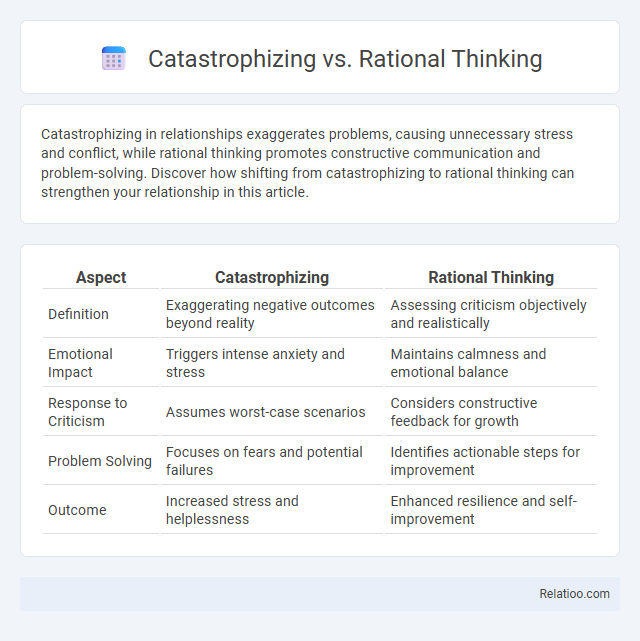Catastrophizing in relationships exaggerates problems, causing unnecessary stress and conflict, while rational thinking promotes constructive communication and problem-solving. Discover how shifting from catastrophizing to rational thinking can strengthen your relationship in this article.
Table of Comparison
| Aspect | Catastrophizing | Rational Thinking |
|---|---|---|
| Definition | Exaggerating negative outcomes beyond reality | Assessing criticism objectively and realistically |
| Emotional Impact | Triggers intense anxiety and stress | Maintains calmness and emotional balance |
| Response to Criticism | Assumes worst-case scenarios | Considers constructive feedback for growth |
| Problem Solving | Focuses on fears and potential failures | Identifies actionable steps for improvement |
| Outcome | Increased stress and helplessness | Enhanced resilience and self-improvement |
Understanding Catastrophizing: Definition and Examples
Catastrophizing is a cognitive distortion where individuals irrationally anticipate the worst possible outcomes, often magnifying minor issues into major disasters. Examples include assuming a small mistake at work will lead to job loss or believing a mild health symptom signals a fatal illness. Understanding catastrophizing helps differentiate it from rational thinking, which involves evaluating situations based on evidence and realistic expectations rather than exaggerated fears.
What Is Rational Thinking? Core Concepts Explained
Rational thinking involves evaluating situations objectively based on evidence and logical analysis, avoiding emotional exaggerations commonly seen in catastrophizing and cognitive distortions. Core concepts include maintaining a balanced perspective, recognizing cognitive biases, and applying problem-solving strategies to make informed decisions. Unlike catastrophizing, which amplifies worst-case scenarios, rational thinking prioritizes realistic appraisals and adaptive responses.
Psychological Roots of Catastrophizing
Catastrophizing originates from cognitive distortions rooted in the brain's tendency to amplify perceived threats, often linked to heightened amygdala activity and impaired prefrontal cortex regulation, which skews rational thinking toward worst-case scenarios. This psychological mechanism fuels anxiety and depressive disorders by triggering exaggerated negative predictions despite limited evidence, diverging significantly from balanced, evidence-based rational thought processes. Understanding the neural and cognitive basis of catastrophizing aids in developing targeted therapies like cognitive-behavioral interventions to recalibrate distorted thinking patterns.
The Impact of Catastrophizing on Mental Health
Catastrophizing, a common cognitive distortion, involves irrationally anticipating the worst possible outcomes, significantly heightening anxiety and stress levels. Rational thinking counters this by promoting balanced evaluation of situations, reducing the risk of overwhelming fear and depressive symptoms. Persistent catastrophizing disrupts emotional regulation, often exacerbating mental health disorders such as generalized anxiety disorder and major depression.
Rational Thinking: Benefits for Emotional Wellbeing
Rational thinking involves evaluating situations based on facts and realistic perspectives, reducing the tendency to catastrophize or engage in cognitive distortions that amplify negative emotions. By fostering clearer, balanced thought processes, it helps your emotional wellbeing through decreased anxiety and improved resilience. Embracing rational thinking techniques promotes healthier decision-making and stress management, supporting overall mental health.
Common Triggers for Catastrophizing Thoughts
Common triggers for catastrophizing thoughts include stressful situations such as health concerns, financial problems, and relationship conflicts. These triggers often amplify cognitive distortions like overgeneralization and magnification, leading to irrational beliefs about worst-case scenarios. Rational thinking counters catastrophizing by evaluating evidence objectively and challenging exaggerated negative predictions.
Techniques to Shift from Catastrophizing to Rational Thinking
Techniques to shift from catastrophizing to rational thinking involve identifying cognitive distortions such as overgeneralization and fortune-telling, then challenging these with evidence-based logic. You can practice mindfulness and cognitive restructuring exercises to recognize irrational fears and replace them with balanced, realistic perspectives. Consistently using thought records and behavioral experiments helps reinforce rational thinking and reduces the intensity of catastrophic predictions.
Real-Life Scenarios: Catastrophizing vs Rational Responses
In real-life scenarios, catastrophizing involves imagining the worst possible outcomes, amplifying stress and anxiety beyond what the situation warrants, while rational thinking assesses facts objectively to formulate balanced and realistic responses. Cognitive distortions like catastrophizing can distort your perception, leading to irrational fears that may hinder decision-making and problem-solving. Recognizing these patterns allows you to challenge negative thoughts and replace them with reasoned perspectives, improving emotional regulation and resilience.
The Role of Cognitive Behavioral Therapy (CBT)
Cognitive Behavioral Therapy (CBT) effectively addresses catastrophizing by helping individuals identify and challenge irrational cognitive distortions, promoting rational thinking patterns. CBT techniques facilitate the restructuring of negative thought cycles, replacing exaggerated fears with realistic appraisals based on evidence. Through cognitive restructuring, CBT enhances emotional regulation and reduces anxiety by fostering balanced perspectives on stressful situations.
Building Resilience Through Rational Mindset
Catastrophizing, a common cognitive distortion, involves envisioning worst-case scenarios that heighten anxiety and weaken emotional resilience. Developing a rational mindset helps you challenge distorted thoughts by evaluating evidence objectively, fostering balanced thinking and emotional stability. Building resilience through rational thinking empowers you to navigate stress effectively, reducing the impact of negative cognitive patterns on mental health.

Infographic: Catastrophizing vs Rational Thinking
 relatioo.com
relatioo.com